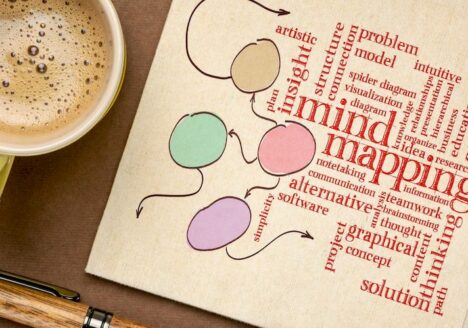Power poses, introduced by Carney, Cuddy, and Yap (2010), are expansive body postures that elicit psychological and physiological changes, such as increased feelings of power, heightened confidence, and reduced stress. Within the CORE Compass framework, power poses serve as a practical tool for fostering balance and growth across its four dimensions: Operational and Physical Vitality, Cognitive Growth, Emotional Equilibrium, and Spiritual Harmony. This article explores the evidence supporting power poses and their applications, weaving research insights and practical advice into a guide for achieving well-being and peak performance.
Beyond their theoretical significance, power poses offer practical strategies that can be easily incorporated into everyday routines to foster balance and resilience. Below are examples of how you can use these poses to enhance well-being and performance in your daily life.
Practicing Power Poses for Balance and Resilience
Power poses are simple to implement and require no special equipment or preparation, making them accessible for anyone. Practicing these poses for just two minutes can result in significant psychological benefits, such as increased confidence, reduced stress, and enhanced mental clarity. Here are three examples tailored to support the CORE Compass dimensions of vitality, resilience, and fulfillment:
- The Wonder Woman Pose
Description: Stand tall with feet hip-width apart, hands firmly placed on your hips, chest lifted, and chin slightly raised.
Application: Use this pose in the morning to set a confident tone for the day or before engaging in important conversations. It energizes both body and mind, supporting resilience and self-assurance. - The Victory Pose
Description: Stand or sit with arms stretched upward in a V shape, chest open, and head slightly tilted back.
Application: Perfect for moments when you need to celebrate small wins or recover emotionally from setbacks. It promotes a sense of accomplishment and vitality. - The Expansive Lean
Description: Lean back with arms stretched across a desk or table, feet firmly planted and slightly apart.
Application: A quick reset for high-pressure moments, this pose helps you stay grounded and regain clarity during stressful tasks.
Incorporating these poses into your daily life can empower you to navigate challenges with balance and resilience while fostering a sense of fulfillment.
Applications in the CORE Compass Framework
Operational and Physical Vitality
Operational and physical vitality centers on the ability to maintain resilience and energy while navigating life’s demands. Power poses contribute by fostering physiological states conducive to vitality. Research by Carney et al. (2010) initially suggested that power poses increase testosterone and reduce cortisol, promoting readiness and resilience. Although hormonal findings have been debated (Ranehill et al., 2015; Simmons & Simonsohn, 2017), other mechanisms, such as reduced stress and enhanced confidence, remain well-supported (Laborde et al., 2019; Garrison et al., 2016).
In professional settings, adopting a confident posture before meetings or presentations helps enhance nonverbal presence and assertiveness (Cuddy, 2015). Körner and Schütz (2020) emphasized that power poses’ effects often intertwine with social roles, noting that expansive postures project dominance, which influences perceptions in social and operational contexts. By occupying more physical space, individuals signal confidence and authority, reinforcing their ability to take decisive action.
Cognitive Growth
Cognitive growth involves mental clarity, focus, and decision-making, key components of the CORE Compass framework. Expansive postures help foster these qualities by reducing anxiety and stress, which impair cognitive processing. Laborde et al. (2019) linked power poses to improved autonomic regulation, aiding cognitive performance. Similarly, Schipper (2018) demonstrated that brief power posing exercises increased classroom participation and confidence, illustrating their potential for enhancing mental engagement.
Beyond stress reduction, Peper et al. (2017) showed that posture significantly affects memory recall and mood, both of which are essential for effective problem-solving and creativity. By adopting a power pose, individuals can improve their mental state, fostering an optimistic outlook that enhances innovation and productivity. Additionally, Muehlhan et al. (2014) found that body posture impacts cognitive performance through its interaction with physiological systems, underscoring the intricate relationship between the body and mind.
Emotional Equilibrium
Emotional equilibrium refers to the ability to maintain a balanced emotional state despite challenges. Power poses are particularly effective in helping individuals manage stress and anxiety. They reduce cortisol levels (Carney et al., 2010) and increase feelings of power, promoting emotional stability (Weineck et al., 2020). This stabilization enables individuals to approach emotionally charged situations with greater calm and confidence.
In moments of emotional turbulence, power poses can act as a quick intervention. For instance, Garrison et al. (2016) showed that the effects of power poses are moderated by social context, suggesting they are particularly impactful in situations involving social interactions. By restoring emotional balance, power poses help individuals recover from emotional disturbances and build resilience over time. However, the effectiveness of power poses may depend on individual differences and situational factors. Davis et al. (2017) conducted a randomized controlled study examining the impact of power posing in individuals with social anxiety disorder. The findings revealed no significant improvement in public speaking performance, highlighting that the benefits of power poses may not extend to all contexts or populations. The key takeaway here is that power poses are a tool, and like any tool, they require skillful use and experimentation. Tailoring their use to your unique needs is essential for achieving balance in Emotional Equilibrium, a core goal of the CORE Compass framework.
Spiritual Harmony
Spiritual harmony within the CORE Compass framework involves achieving inner peace, aligning with values, and fostering a sense of purpose. Although power poses are primarily physical in nature, their psychological effects—such as enhanced confidence and reduced internal conflict—can indirectly contribute to spiritual well-being (Cuddy, 2015). By fostering empowerment, expansive postures help individuals act with greater authenticity, aligning more closely with their personal and spiritual values.
Aristotle’s philosophical principles, as discussed in De Anima and Nicomachean Ethics, provide a historical foundation for the relationship between body and mind (Lawson-Tancred, 1986; Ross & Brown, 2009). Aristotle emphasized the harmony of body and soul as essential for achieving eudaimonia, or flourishing. Power poses embody this principle by aligning physical stances with psychological states, enabling individuals to connect with their higher purpose.
Mehrabian (1982) further highlighted how nonverbal cues, such as posture, influence not only interpersonal interactions but also self-perception. Expansive postures can therefore act as a bridge between physical presence and spiritual alignment, promoting openness and presence during mindfulness or meditation practices.
Benefits within the CORE Compass Framework
- Enhanced Physical and Operational Vitality
Power poses foster resilience, readiness, and operational efficiency through stress reduction and the projection of confidence (Laborde et al., 2019; Carney et al., 2010). - Improved Cognitive Function and Creativity
By enhancing mood and reducing anxiety, power poses support mental clarity and innovation, critical for cognitive growth (Peper et al., 2017; Schipper, 2018). - Balanced Emotional State
Power poses aid emotional regulation, helping individuals manage stress and maintain equilibrium in challenging situations (Weineck et al., 2020; Garrison et al., 2016). - Strengthened Spiritual Alignment
By fostering self-confidence and authenticity, power poses contribute to spiritual harmony and alignment with personal values (Cuddy, 2015; Lawson-Tancred, 1986).In addition to their accessibility and ease of use, power poses provide measurable benefits across the CORE Compass dimensions, as detailed below.
How to Integrate Power Poses into CORE Compass Practices
- Daily Routine Integration
Start the day with power poses to set a positive tone and reduce stress. Integrate them before physical or mental challenges to enhance vitality and focus. - Pre-Meeting and Pre-Task Preparation
Use power poses to boost confidence and nonverbal presence before professional interactions or high-stakes tasks (Cuddy, 2015). - Mindful Practice
Combine power poses with mindfulness or meditation exercises, focusing on body-mind alignment to foster spiritual harmony and emotional balance. - Stress Management Tool
Apply power poses as an immediate intervention during stressful moments to restore emotional stability and maintain focus (Peper et al., 2017; Laborde et al., 2019).
Conclusion
Power poses offer a versatile and evidence-based approach for enhancing vitality, growth, equilibrium, and harmony within the CORE Compass framework. By integrating these practices into daily routines and high-stakes scenarios, individuals can achieve greater resilience, improved performance, and a more balanced life. As ongoing research continues to refine our understanding of their effects, power poses remain a valuable tool for cultivating well-being and self-empowerment.
References
Carney, D.R., Cuddy, A.J.C. and Yap, A.J. (2010). Power posing: brief nonverbal displays affect neuroendocrine levels and risk tolerance. Psychological Science, 21(10), pp. 1363–1368.
Cuddy, A.J.C., Schultz, S.J. and Fosse, N.E. (2018). P-curving a more comprehensive body of research on postural feedback reveals clear evidential value for power-posing effects: Reply to Simmons and Simonsohn (2017). Psychological Science, 29(4), pp. 656–666.
Cuddy, A.J.C. (2015). Presence: bringing your boldest self to your biggest challenges. Retail ed., unabridged. New York: Hachette Audio.
Davis, M.L., Papini, S., Rosenfield, D., Roelofs, K., Kolb, S., Powers, M.B. and Smits, J.A.J. (2017). A randomized controlled study of power posing before public speaking exposure for social anxiety disorder: no evidence for augmentative effects. Journal of Anxiety Disorders, 52, pp. 1–7.
Garrison, K.E., Tang, D. and Schmeichel, B.J. (2016). Embodying power: A preregistered replication and extension of the power pose effect. Social Psychological and Personality Science, 7(7), pp. 623–630.
Körner, R. and Schütz, A. (2020). Dominance or prestige: A review of the effects of power poses and other body postures. Social and Personality Psychology Compass, 14(8), e12559.
Laborde, S., Strack, N. and Mosley, E. (2019). The influence of power posing on cardiac vagal activity. Acta Psychologica, 199, p. 102899.
Lawson-Tancred, H. (ed.) (1986). De anima (on the soul). Penguin classics. Harmondsworth: Penguin Books.
Mehrabian, A. (1982). Nonverbal communication. New York: Aldine Publishing.
Muehlhan, M., Marxen, M., Landsiedel, J., Maluck, E., Wintermann, G.B. and Voss, A. (2014). The effect of body posture on cognitive performance: a question of sleep quality. Frontiers in Human Neuroscience, 8, p. 171.
Peper, E., Lin, I.M., Harvey, R. and Perez, J. (2017). How posture affects memory recall and mood. Biofeedback, 45(2), pp. 36–41.
Ranehill, E., Dreber, A., Johannesson, M., Leiberg, S., Sul, S. and Weber, R.A. (2015). Assessing the robustness of power posing: no effect on hormones and risk tolerance in a large sample of men and women. Psychological Science, 26(5), pp. 653–656.
Ross, W.D. and Brown, L. (2009). The Nicomachean ethics. Oxford world’s classics. ed. rev. Oxford: Oxford University Press.
Schipper, S. (2018). Power posing for increased participation in the EFL classroom. The Language Teacher, 42(6), pp. 9–11.
Simmons, J.P. and Simonsohn, U. (2017). Power posing: p-curving the evidence. Psychological Science, 28(5), pp. 687–693.
Weineck, F., Messner, M., Hauke, G. and Pollatos, O. (2020). Improving interoceptive ability through the practice of power posing: a pilot study. PLOS ONE, 15(2), p. e0228820.




